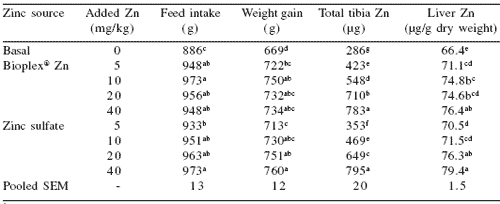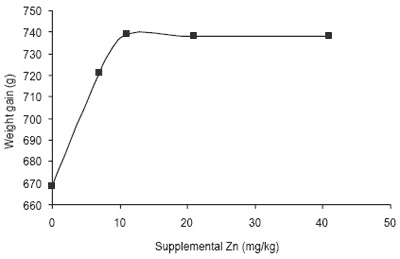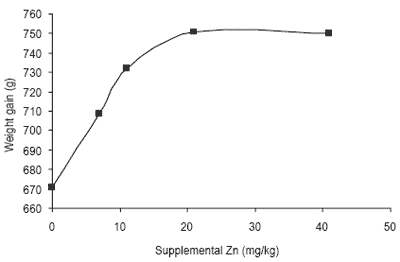Bioplex® Zn: redefining the zinc requirement of chicks during the starter phase
Zinc (Zn) is an essential nutrient for the normal growth and feathering of chicks (O’Dell and Savage, 1957; 1960). The zinc requirement for chicks was first defined as 30 ppm by Roberson and Schaible (1958) and later revised to 40 ppm for broilers (NRC, 1994).
However, much of the data on which these requirements were based may not be applicable to modern commercial poultry strains (Leeson, 2005). Concomitantly, in recent years organically-complexed mineral sources, e.g., proteinates and amino acid chelates, have been increasingly used to supplement poultry diets because of their higher bioavailability (Wedekind and Baker, 1989; Wedekind et al., 1992; Cao et al., 2000) and lower manure loading (Mañón et al., 2005; Pierce et al., 2005).
Because inconsistent research results have been reported concerning the bioavailability of organic zinc sources compared with inorganic sources (Hill et al., 1986; Pimentel et al., 1991; Ammerman et al., 1995), the aim of this trial was to compare the relative bioavailability of Bioplex® Zn (a chelated Zn proteinate, Alltech Inc.) with reagent grade ZnSO4•7H2O in broiler chicks. In addition, we re-evaluated the requirement for zinc for optimal growth of broiler chicks in the starter phase. A practical corn soybean meal diet was used.
Materials and methods
A total of 432 one-day-old male broiler chicks were randomly distributed to each of nine dietary treatments with eight replicate cages of six chicks. The study lasted 21 days. A cornsoybean meal basal diet (Table 1) was formulated to be adequate in all nutrients except zinc (NRC, 1994). The zinc concentration of the basal diet was 23 mg/kg.
Dietary additions of Zn included 5, 10, 20 and 40 mg/kg diet as reagent grade Zn sulfate (ZnSO4•7H2O) or Bioplex® Zn (10% Zn). Chicks were weighed weekly. On day 21, three chicks from each cage (24 chicks per treatment) were randomly selected and killed by asphyxiation with argon followed by cervical dislocation. The liver and right tibia were removed and pooled by cage. Bones were defatted using petroleum ether and dry-ashed at 600 ºC overnight in a muffle furnace. The liver and bone ash were microwave-digested with nitric acid (AOAC, 1995). The zinc concentrations in feed and tissue samples were determined using an inductively coupled plasma optical emission spectrometer (ICP-OES).
Table 1. Ingredient and composition (as-fed basis) of the basal diet.1
1Contained 23 mg Zn/kg by analysis.
2Supplied per kg diet: 11,025 IU vitamin A, 3,528 IU vitamin D3, 33 IU vitamin E, 0.91 mg vitamin K, 2 mg thiamin, 8 mg riboflavin, 55 mg niacin, 18 mg Ca pantothenate, 5 mg vitamin B6, 0.221 mg biotin, 1 mg folic acid, 478 mg choline, 28 μg vitamin B12.
3Supplied per kg diet: 80 mg iron, 60 mg manganese, 13 mg copper and 0.15 mg selenium.
Data were analyzed by ANOVA for a randomized complete block design using the linear model of Statistix 8 (2003) (Analytical Software, Tallahassee, FL). Mean differences were determined using Fisher’s least significant difference test. Linear and quadratic effects were tested using polynomial contrasts. A SAS (2003) NLIN procedure was used to determine the break point wherein the weight gain or total tibia zinc content was regressed on dietary supplemental zinc concentration. A single slope, broken line method, as described by Robbins (2006), was used to determine break point and slope below the break point.
Results
GROWTH PERFORMANCE AND TISSUE ZINC CONTENT
Dietary additions of zinc from either source increased feed intake and liver zinc content (P<0.01). Weight gain increased linearly (P<0.01, Table 2) with dietary zinc from Bioplex® Zn up to 10 ppm and from zinc sulfate up to 20 ppm. The broken line analysis of weight gain regressed on supplemented dietary zinc level showed the break point for Bioplex® Zn to be 9.8 ppm (P<0.05, r2=0.95) (Figure 1) vs 20.1 ppm for zinc sulfate (P<0.05, r2=0.98) (Figure 2). The supplemental level of 20.1 ppm Zn is close to the NRC (1994) requirement of 40 ppm when the basal level of 23 ppm Zn is considered.
This result is also consistent with the data reported by Batal et al. (2001). The slope ratio between Bioplex® Zn and ZnSO4 below the break point gave a relative bioavailability for Bioplex® Zn based on weight gain of 183% compared with zinc sulfate.
TIBIA ZINC CONTENT
Dietary supplementation of Bioplex® Zn at 5, 10, and 20 ppm significantly increased total tibia zinc content compared with zinc sulfate. The broken-line analysis of total tibia zinc content regressed on supplemental dietary zinc level showed the break point to be 17.5 ppm (P<0.01, r2=0.98) for Bioplex® Zn.
The relative bioavailability of Bioplex® Zn based on the slope ratio of tibia zinc content below the break point was 157%. This finding is consistent with that of Cao et al. (2000) who reported that the bioavailability of zinc from proteinate was 139% that of zinc sulfate based on multiple linear regression slope ratio of bone zinc.
Table 2. Performance and tissue zinc content of chicks fed Bioplex® Zn and zinc sulfate in a corn-soybean meal diet.1
1The performance data represent means of eight replicate groups of six chicks during the period 1 to 21 days.
The tissue data represent means of eight replicate groups of three chicks.
a, b, c, d, e, f, g P<0.01.
Figure 1. Broken line analysis plot of weight gain as a function of supplemental zinc as Bioplex® Zn. Break point occurred at 9.8 mg/kg diet.
Figure 2. Broken line analysis plot of weight gain as a function of supplemental zinc as zinc sulfate. Break point occurred at 20.1 mg/kg diet.
Implications
The bioavailability of Bioplex® Zn was 183% that of zinc sulfate based on the weight gain data and 157% that of zinc sulfate based on the total tibia zinc content. Overall, we found the zinc requirement for optimal growth of broiler chicks during the starter phase (days 1 – 21) can be met with Bioplex® Zn at 9.8 mg Zn/kg of corn-soy diet compared with 20.1 mg Zn/kg for zinc sulfate. Thus, Bioplex® Zn provides a powerful tool for reducing the environmental impact of poultry production, while maintaining optimal animal performance.
References
Authors: T. AO, J.L. PIERCE, R. POWER, K.A. DAWSON, A.J. PESCATORE, A.H. CANTOR and M.J. FORDAOAC. 1995. Official Methods of Analysis. Association of Official Analytical Chemists, Washington, DC.
Ammerman, C.B., D.H. Baker and A.J. Lewis. 1995. Bioavailability of Nutrients for Animals: Amino Acids, Minerals, and Vitamins. Academic Press, San Diego, CA.
Batal, A.B., T.M. Parr and D.H. Baker. 2001. Zinc bioavailability in tetrabasic zinc chloride and the dietary zinc requirement of young chicks fed a soy concentrate diet. Poult. Sci. 80:87-90.
Cao, J., P.R. Henry, R. Guo, R.A. Holwerda, J.P. Toth, R.C. Littell, R.D. Miles and C.B. Ammerman. 2000. Chemical characteristics and relative bioavailability of supplemental organic zinc sources for poultry and ruminants. J. Anim. Sci. 78: 2039- 2054.
Finney, D.J. 1978. Statistical Method in Biological Assay (3rd ed.). Charles Griffin and Co., London.
Hill, D.A., E.R. Peo, Jr., A.J. Lewis and J.D. Crenshaw. 1986. Zinc amino acid complexes for swine. J. Anim. Sci. 63:121.
Leeson, S. 2005. Trace mineral requirements of poultry – validity of the NRC recommendations. In: Re-defining Mineral Nutrition. (L.A. Tucker and J.A. Taylor- Pickard, eds). Nottingham University Press, Nottingham, UK, pp. 107-117.
Mañón, A., A. Cantor, A. Pescatore, M. Ford, H. Gillespie and M. Daley. 2005. Influence of dietary supplementation of organic minerals and phytase on mineral concentration in manure of replacement pullets. Poultry Sci. 84 (Suppl. 1):85.
National Research Council. 1994. Nutrient Requirements of Poultry. 9th rev. ed. National Academy Press, Washington, DC.
O’dell, B.L. and J.E. Savage. 1957. Symptoms of zinc deficiency in the chick. Proc. Fed. Soc. 16:394.
O’dell, B.L. and J.E. Savage. 1960. Effect of phytic acid on zinc availability. Proc. Soc. Exp. Bio. Med. 103:304.
Pierce, J.L., B.L. Shafer, R. Power and K.A. Dawson. 2005. Nutritional means to lower trace mineral excretion from poultry without compromising performance. Poultry Sci. 84 (Suppl. 1):11.
Pimentel, J.L., M.E. Cook and J.L. Greger. 1991. Research note: Bioavailability of zinc methionine for chicks. Poult. Sci. 70:1637.
Robbins, K.R., A.M. Saxton and L.L. Southern. 2006. Estimation of nutrient requirements using broken line analysis. J. Anim. Sci. 84:E155-E165.
Roberson, R. and P. J. Schaible. 1958. The zinc requirement of the chick. Department of Poultry Science, Michigan State University.
SAS 9.1. 2003. SAS Institute Inc., Cary, NC, USA.
Wedekind, K.J. and D.H. Baker. 1989. Zinc bioavailability in feed-grade zinc sources. J. Anim. Sci. 67 (Suppl. 2):126.
Wedekind, K.J., A.E. Hortin and D.H. Baker. 1992. Methodology for assessing zinc bioavailability: Efficacy estimates for zinc methionine, zinc sulfate, and zinc oxide. J. Anim. Sci. 70:178-187.
Alltech-University of Kentucky Nutrition Research Alliance, Lexington, Kentucky, USA








